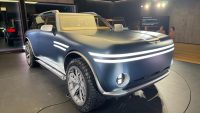 THE BMW 5 Series has been with us for almost four decades, and shows no signs of waning. Rumored to be BMW’s most profitable model line, the current range is extensive, uses cutting-edge technology, and looks set to further sales which today stand at more than 5.5 million.
THE BMW 5 Series has been with us for almost four decades, and shows no signs of waning. Rumored to be BMW’s most profitable model line, the current range is extensive, uses cutting-edge technology, and looks set to further sales which today stand at more than 5.5 million.
Why 5 Series, though? Quite simply, because it was the fifth of BMW’s ‘new series’ of models. From aircraft engines back in the day, the Bavarian maker had taken an unconventional approach to post-war car design, majoring on bubble cars and other quirks. Slowly, though, it had begun to deliver ‘prober’ cars. The 1972 5 Series was a core next step in its development.
Designed to rival the already-established Mercedes W114 saloon, it was a conventional three-box shape, with a familiar range of four-cylinder engines. In-line six-cylinder units were also offered though, starting with the 525i that today is a classic name in BMW history. Indeed, the ‘72 5 Series started the three-digit BMW naming trend.
It was facelifted in 1977, but you couldn’t really tell. Indeed, the 1982 E28 was, unusually, very similar to the basic model that had run for a decade too, despite being all-new. Customers struggled to appreciate just how advanced it was; that’s why an all-new one arrived relatively soon after, in 1988.
What a beauty the E34 5 Series was. Probably THE classic 5 Series shape, it remains modern in appearance today, with elegance that has stood the test of time. This model marked the arrival of the Touring variant too, further bolstering the 5 Series offer for BMW car dealers.
The best overall 5 Series, though, may in time be credited to the E39 version, that came in 1995. At the time, BMW almost lost count of the number of 5-star road test reviews this monumentally well developed machine won. It was utterly divine to drive, particularly the 400bhp V8 M5 version, and is today revered in the trade for its completeness.
Car dealers willingly put these on their forecourts, because they know it will do the business, and that customers will always be there for it. Its successor, the E60 of 2003, is more controversial. The first ‘Bangle-designed’ 5 Series, those beautiful lines and curves were replaced with more avant-garde edges and angles.
Thing is, it’s a model that really is maturing well. Today, the E60 appears uncommonly well proportioned and although it’s now been replaced by last year’s F10 5 Series, the trade should not worry about its long-term strength. So advanced was it at the time, it’s not going to look dated any time soon.
 Now, we’re on generation six of the 5. It’s more efficient than ever, with the best-selling 520d model capable of well over 50mpg.
Now, we’re on generation six of the 5. It’s more efficient than ever, with the best-selling 520d model capable of well over 50mpg.
The Touring version has just been launched, and rumour is a hot new M5 is not far away, boasting more power AND more economy over the controversial V10 M5 that preceded it. Apparently, it’s going to mark a return to the V8 M5 concept – but this time, with twin turbos…
BMW can retain this sporting focus for the 5 Series because, nowadays, it has diversified the range. By launching the 5 Series GT, those seeking a more practical alternative for passengers have been catered for – so the saloon and Touring cans stick to doing what they know best. As such, it is THE benchmark in the executive car sector.
With Audi’s A6 and Mercedes’ E-Class, the 5 Series defines the large exec sector. All have their own distinct personalities, but it’s the 5 Series that has the longest-running naming line, and thus the clearest progression through history. 5.6 million means it sure is a sales legend, that shows no signs of tailing off just yet…

































